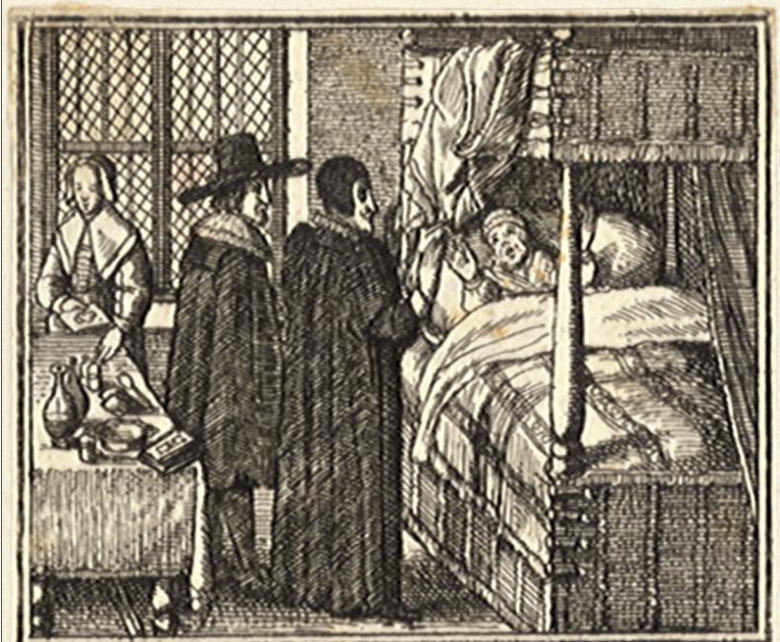The daughter of John Tradescant the Younger, Frances was painted by an unidentified artist sometime around 1638. She is bareheaded, but has dressed her hair with a blue ribbon that picks out the ribbons and laces on her bodice which whilst not really high quality is nicely embroidered around the buttons holding the slashes in her sleeves together. The tabs on the bodice look like they are edged with embroidery too. A tidy kerchief edged with wide needlelace covers her neckline. You can see this picture in the Ashmolean Museum of Art and Archaeology. © 2011 University of Oxford – Ashmolean Museum
Old Tom Parr
Reputedly the oldest man in England when he died in 1635, Tom Parr claimed to have been born in 1483 which made him 152. The cause of death was declared by William Harvey to have been overexposure. The pressures of fame. Tom wears a simply cut, possibly russet doublet with shoulder wings and a small collar band. He’s also knotted something around his waist to act as a belt. There are several versions of this picture. This one hangs in the Ashmolean Museum in Oxford.
Robert Dingley
Pictured on the front page of his tome The Spiritual Taste Described and a Glimpse of Christ Discovered, published in 1649 and engraved by Thomas Cross. Dingley wears a black doublet with a collared cloak, small falling band and black day cap. Note the buttons on the collar and all the way down the front for fastening the cloak for inclement weather, though for the picture, Robert wears it in the off the shoulder manner of religious portraits of the time. Presumably the garment is held on by some kind of strap that fixes around the arms. Although it looks like a coat and it has neck shaping, I believe the wide flap collar at the back marks it as a cloak. Coats at this time generally had no collar or a short stiffened band.
Walter Strickland
Painted by Dutch artist Pieter Nason in 1651, Walter Strickland was for the whole of the war English ambassador to the Netherlands and recalled in 1650, returning in 1651 when presumably this picture was painted. Walter wears what looks like a silk brocade doublet with slashed sleeves, black unconfined breeches (notice the ribbon decoration), and a velvet cloak. He is also wearing some fine leather gloves, and outrageously long black leather shoes. Picture hangs in Sewerby Hall Museum in Bridlington
A Manual of Directions
for the Visitation of the Sick with sweet Meditations & Prayers to be used in time of sickness by Lancelot Andrewes late Bishop of Winchester. Andrewes was one of the more moderate independant clergy and had some influence on the young Charles, though he was dead long before war broke out. In the frontispiece by Hollar from the 1642 edition, we see two professional gents (either could be doctor or priest) visiting a poor soul in his sickbed with a serving girl busying herself behind a table.
Looking at the picture in more detail we can see the woman on the left is dressed in a laced bodice, over which she wears a neckerchief and linen coif on her head. The two gents are dressed professionally, on the left in a cloak, ruff and wide brimmed hat and on the right in a gown and day cap. It’s almost impossible to decide which is doctor and which is clergy as both professions would have worn either garb, though maybe the vicar is the one on the right with his hand raised in blessing. The patient has a fringed night cap on his head and presumably a shirt, though the detail is a bit scratchy when you look closely. It does look however that he’s thrown his doublet over the top of his bed. Nice collection of living history objects on the table.
Thomas Heyton
Also painted by Thomas Leigh in 1634, Thomas is derssed in a similar fashion to his wife Isobel, though we can only see his shirt and the fur lined wrap over his shoulders. We can see however that the shirt is of fine linen and that the collar is integral to the shirt. The lace is small but really good quality and if you look closely you can see a dart in the band on his right hand side. This picture also hangs in Trerice, Cornwall. I hope they’re still together.
Isobel Heyton
Painted in 1634 by Thomas Leigh, Isobel was wife of Thomas Heyton. Sadly I can find nothing about Isobel or Thomas,or even the artist, but Isobel is painted in a low cut silk waistcoat over a linen smock with a high collar, edged in lace. The waistcoat is edged with spangled lace as is the silk, embroidered wrap or mantle draped over her shoulder. The picture hangs in Terice, Cornwall and is kept by the National Trust










